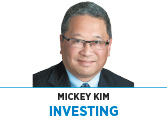Subscriber Benefit
As a subscriber you can listen to articles at work, in the car, or while you work out. Subscribe Now Who can forget the Muppets’ “Alphabet Song” on Sesame Street? “B” is for Bert. “C” is for Cookie Monster. Certainly not Wall Street pundits, who debated which letter would best describe the path of the eventual post-COVID recovery.
Who can forget the Muppets’ “Alphabet Song” on Sesame Street? “B” is for Bert. “C” is for Cookie Monster. Certainly not Wall Street pundits, who debated which letter would best describe the path of the eventual post-COVID recovery.
Would it be a “V” (sharp decline-sharp rebound), “W,” “U,” “L,” or even a “Nike Swoosh?”
The letter “K” is a vertical line with two 45-degree lines slanting from the middle, one upward and one downward, and unfortunately it best describes the paths of the economy and stock market since the nadir (we hope) of the COVID pandemic in March.
The gap between the “haves” and “have-nots” has further widened over the intervening six months, resulting in the “haves” having more (sometimes much more) and the “have nots” having less (oftentimes much less).
The “happy,” upward-slanting line symbolizes those parts of the economy that actually benefited from the pandemic.
Technology companies like Apple and Zoom gained from the massive, instantaneous switch to “work from home (WFH).” Netflix kept us entertained. Target and Walmart sold copious amounts of household staples. Home Depot and Lowe’s gained as folks decided to fix up their homes. Amazon continued to grab market share from brick-and-mortar competitors.
To no surprise, the Direxion Work From Home ETF (Ticker: WFH) was recently launched to make it easy for the Robin Hood crowd to jump on the bandwagon with a single click.
The “sad,” downward-slanting line symbolizes pretty much everything else.
The list of companies hurt by the pandemic is much longer and contains a boatload of bankruptcies, with more sure to come. For retailers that were already teetering—like J.C. Penney and Pier One—the pandemic was the final straw. Any business dependent on physical customers—like airlines, hotels and restaurants—is facing an existential crisis.
The situation is even more dire for small, privately held businesses, which employ the majority of Americans. Yelp reported that, as of the end of August, 163,735 businesses indicated they were closed, up 23% from July. Further, the National Restaurant Association said at least 100,000 restaurants are closed (nearly one in six) and 3 million restaurant employees are without a job. Alarmingly, with cold weather approaching, 40% of owners surveyed said they are likely to close within six months without additional government support.
On Feb. 19, the S&P 500 reached a record high. As the government effectively shut down the economy in an attempt to contain the pandemic, panic ensued, with the S&P 500 plunging 34% over five weeks. Incredibly, by Sept. 2, the S&P 500 made a new record high, as investors seemingly put COVID in the rearview mirror.
How can you reconcile the disconnect between the joy on Wall Street and the continuing pain on Main Street?
First, there is an old investing adage, “Don’t fight the Fed,” which means, if the Federal Reserve wants to support stocks with lower interest rates (like now), stock prices are unlikely to act contrary.
Second, the lower the interest rate, the higher the multiple of earnings investors are willing to pay, resulting in higher stock prices. Further, with bond yields near zero, investors are facing the reality of TINA, or There is No Alternative (to stocks).
Third, this is one of those times the S&P 500 is a terrible proxy for the performance of the “average” stock. The S&P 500 is a capitalization-weighted index, which means the performance of the largest-capitalization stocks affect returns much more than the smaller-capitalization stocks.
For instance, Apple recently became the first U.S. company to attain a market capitalization of $2 trillion, more than the total market capitalization of the entire Russell 2000 small-capitalization index. Indeed, the “Fab-Five” largest-capitalization stocks in the S&P 500 (i.e. 1% of the stocks)—Apple (up 76% for the year through August), Amazon (87%), Microsoft (43%), Google parent Alphabet (22%) and Facebook (43%)—recently had a combined index weight of 23%.
Indeed, while the S&P 500 had a total return of 9.7% through August, the version of the S&P 500 that gives an equal 0.2% weight to each of the 500 stocks had a total return of minus 2.3%. Clearly, the massive gains in the mega-capitalization technology stocks have masked weakness in low-index-weight sectors that have been decimated,•
__________
Kim is Kirr Marbach & Co.’s chief operating officer and chief compliance officer. He can be reached at 812-376-9444 or [email protected].
Please enable JavaScript to view this content.

An interesting article, Mickey, but there’s an error in the synopsis given in the “Eight at Eight” reference to your piece. You didn’t repeat it here, however.
To wit: The intro teaser in Eight @ Eight said the K-car saved Chevrolet. Wrong: It was the 1981 Plymouth Reliant and Dodge Aries K-car twins that saved Chrysler Corporation. They had nothing to do with General Motors or Chevrolet Motor Division thereof.